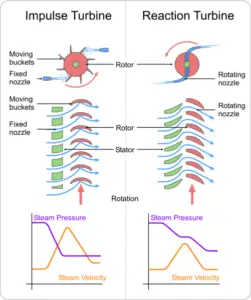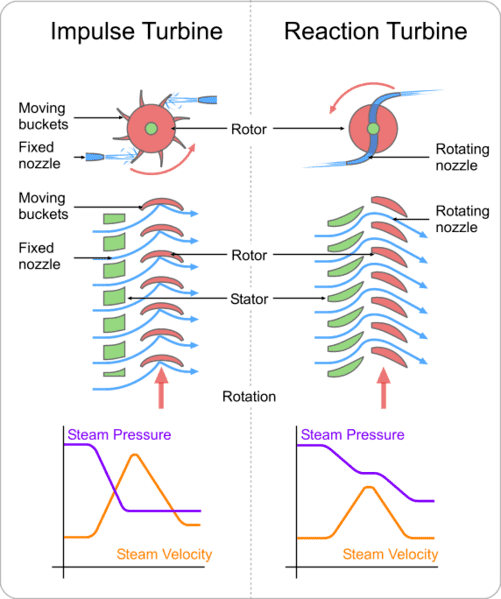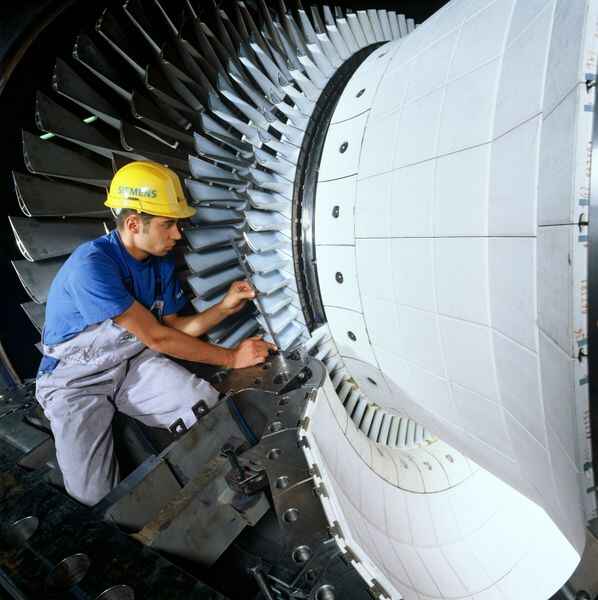Working Principle of Steam Turbine Explained
The working principle of steam turbine is made up of three stages that include; thermally-induced vaporization, vapor pressure-application, and mechanical rotation.
This article discusses the working principle of a steam turbine, as follows;
1). Thermally-induced Vaporization (in explanation of the Working Principle of Steam Turbine)
Thermally-induced vaporization is the first stage in the working principle of a steam turbine, and it describes the role of thermal energy in generating steam which is the primary working fluid in the system.
Vaporization occurs when water is subjected to heating, till it begins to boil.
In a traditional steam turbine, the working fluid undergoes a thermodynamic cycle called the Rankine cycle; which describes the changes in temperature, pressure and phase of water as it is heated, vaporized, and used to drive the blades of the turbine [1].
The Rankine cycle is highly idealized, and assumes that energy waste in a steam turbine is minimal. However, in real life scenarios this is not the case, due to various avenues by which energy is lost from the system. One of these avenues is described simply as thermal stress.
Thermal stress in a steam turbine is the sum-total of stresses caused by steep temperature gradients and dis-uniform thermal conductivity, in materials and components that have limited thermal-expansion capacity [4].
Turbine thermal expansion refers to all volumetric changes that occur in the parts and working fluid of the turbine, as a result of heat. Such expansion occurs during and immediately-after the vaporization of water to produce steam, and affect the boiler, steam circulatory system, and the turbine itself.
Energy losses as a result of thermal stress occur in the form of friction and radiated heat, and can lower the efficiency and working condition of the steam turbine.
Generally, the performance of a steam turbine with respect to thermal processes, depends on its thermal energy efficiency (or thermal efficiency, for short).
Thermal efficiency for most steam turbines, ranges between 40 and 60%, and can be improved by modifying the design and materials of the turbine.
2). Vapor Pressure Application
After vapor has been produced using thermal energy, it is then used to apply pressure to the movable parts of the steam turbine.
In addition to pressure, vapor applies thermal energy and velocity to the turbine, as it comes in contact with it.
As high-pressure steam enters the nozzle of a steam turbine, its pressure is intensified by compression, with temporary decrease in volume. This intensification of pressure is what enables steam to be delivered from the boiler to the turbine with high impulsive force.
The steam pressure for a turbine may vary depending on the design and operating specifications of the turbine, so that it ranges from less than 50 to above 200 psig. Based on steam pressure, turbines can be differentiated into high- and low-pressure categories.
As earlier stated, vapor pressure in a steam turbine is applied alongside temperature and velocity.
The Second Law of thermodynamics can be used to explain the process of vapor pressure application in a steam turbine, as it describes the transfer of thermal energy from a higher level to a lower level. It also explains the loss of energy in the form of heat, that occurs as this transfer takes place [2].
Pressure and temperature proportionality as illustrated by the Gas Laws indicates that heat losses imply pressure losses for the steam turbine. This is also accompanied by an increase in volume, that occurs by the expansion of steam as its temperature decreases.
The effect of inlet pressure in a steam turbine is mechanical energy production, provided this pressure is sufficient to cause significant rotation of the movable parts of the turbine.
An understanding of the thermodynamic principles and gas laws is very important when designing and studying steam turbines, because these govern how steam interacts with the turbine components, and therefore determines the performance of the turbine.
With an efficient design, steam (vapor) generated in the boiler can produce mechanical rotations when it is introduced into the turbine chamber under high pressure.
3). Mechanical Rotation (in explanation of the Working Principle of Steam Turbine)
A steam turbine converts thermal energy, pressure and velocity to mechanical energy of rotation in its movable parts such as the blades.
Turbines are rotated by the process of energy capture, where kinetic energy of a moving fluid is captured as the fluid comes in contact with a movable parts of the turbine, thereby causing rotary motion [3].
The rotation of a steam turbine can be measured according to number of rotations per minute (rpm), which in turn depends on the design of the turbine and the impulsive force of the working fluid.
It may also be clockwise or anti-clockwise, although most steam turbines rotate anti-clockwise, because this is a more convenient design for the overall working of the system.
Mechanical rotation is a very important aspect of the working principle of steam turbines, because it signifies the complete conversion of steam thermal energy and pressure to mechanical energy that can be used for electricity generation, among other purposes.
After rotation has been induced, steam may leave the turbine casing through an exhaust, and may be either condensed to form water that can be recycled as feeder supply for the boiler, or may be collected as steam and reused for other thermal-related purposes.

Summary Illustration of Working Principle of Steam Turbine for Impulse and Reaction Types Respectively (Credit: Emoscopes 2006 .CC BY-SA 3.0.)
Conclusion
The working principle of a steam turbine comprises of;
1. Thermally-induced Vaporization
2. Vapor Pressure Application
3. Mechanical Rotation
References
1). Huijun, F.; Chen, L.; Tang, W.; Ge, Y. (2022). "Optimal Design of a Dual-Pressure Steam Turbine for Rankine Cycle Based on Constructal Theory." Energies 15(13):4854. Available at: https://doi.org/10.3390/en15134854. (Accessed 3 March 2023).
2). Karaağaç, M. O.; Kabul, A.; Ogul, H. (2019). "First- and second-law thermodynamic analyses of a combined natural gas cyclepower plant: Sankey and Grossman diagrams." Turkish Journal of Physics 43(1):93-108. Available at: https://doi.org/10.3906/fiz-1809-9. (Accessed 3 March 2023).
3). Omosanya, A. J.; Akinlabi, E.; Okeniyi, J. O. (2019). "Overview for Improving Steam Turbine Power Generation Efficiency." Journal of Physics Conference Series 1378(3):032040. Available at: https://doi.org/10.1088/1742-6596/1378/3/032040. (Accessed 3 March 2023).
4). Rusin, A.; Lukowicz, H.; Kosman, W. (2014). "Transient Temperature and Thermal Stresses in Turbine Components." In: Hetnarski, R.B. (eds) Encyclopedia of Thermal Stresses. Springer, Dordrecht. Available at: https://doi.org/10.1007/978-94-007-2739-7_416. (Accessed 3 March 2023).

